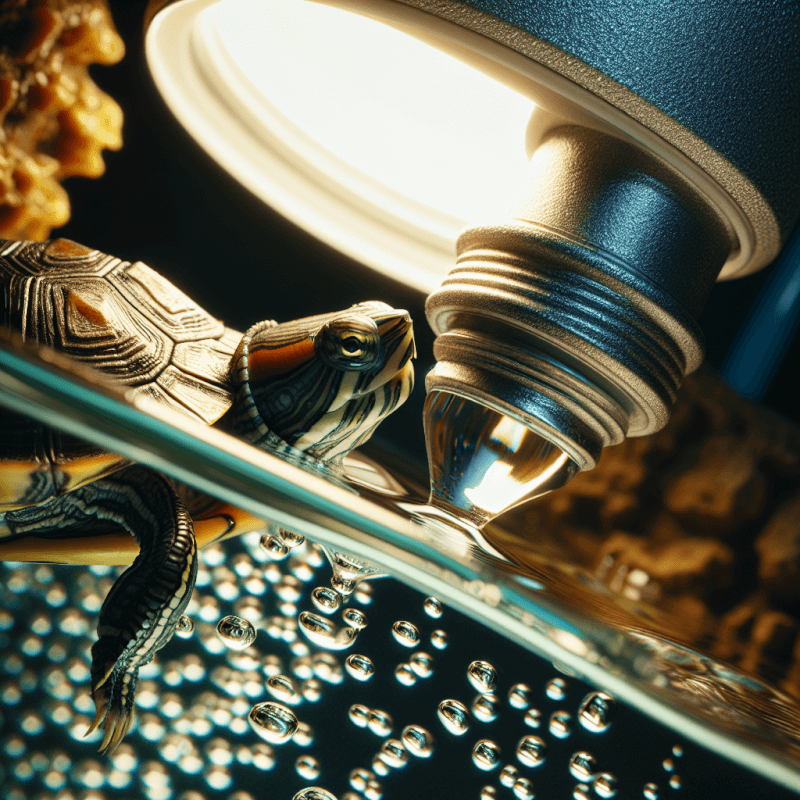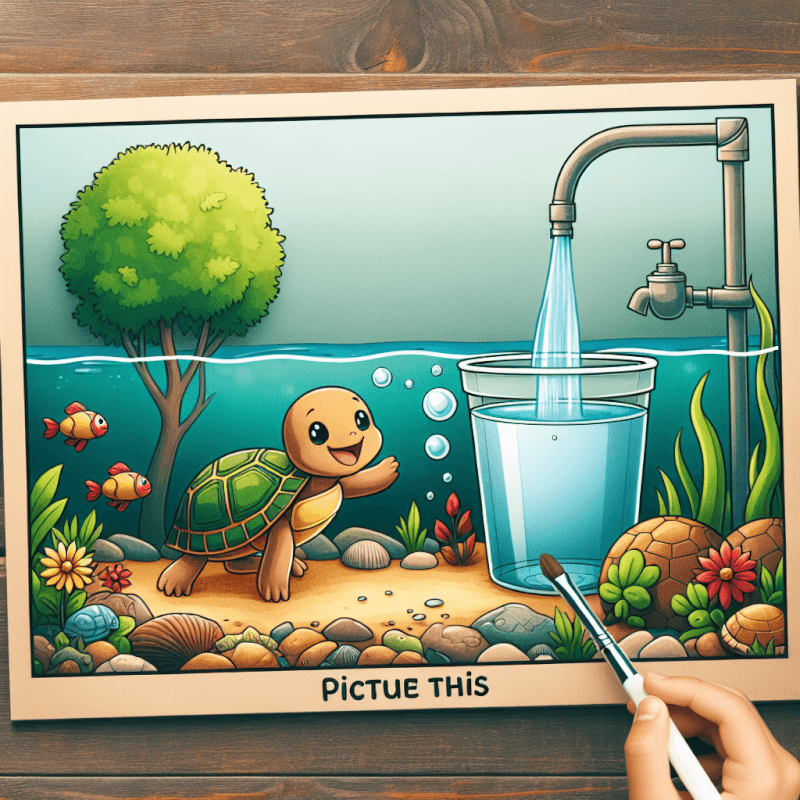Are you a proud owner of a pet turtle and wondering if tap water is safe for them? Well, you’ve come to the right place! In this article, we will explore the topic of whether tap water is a suitable choice for your beloved shelled friend. We’ll discuss the potential risks associated with tap water and provide you with some tips on how to ensure your pet turtle stays healthy and hydrated. So, let’s jump right in and discover the best water source for your aquatic companion!
Water Quality
When it comes to the health and well-being of your pet turtle, water quality is of utmost importance. Tap water, while generally safe for human consumption, may not be suitable for your turtle’s needs. There are several factors to consider when it comes to water quality, including chlorine and chloramine levels, heavy metals, pH levels, ammonia, and fluoride.
Chlorine and Chloramine
Many municipal water sources add chlorine or chloramine to disinfect the water and remove harmful bacteria. While this is necessary for human consumption, these chemicals can be harmful to turtles. Chlorine can irritate their skin and eyes, while chloramine can interfere with their respiratory system. It is important to remove these substances from tap water before using it for your turtle.
Heavy Metals
Another concern with tap water is the presence of heavy metals. These include lead, copper, and zinc, which can be introduced into the water supply through aging pipes or industrial runoff. Heavy metals can accumulate in your turtle’s body over time, leading to organ damage and other health issues. Ensuring the removal of heavy metals is essential for your turtle’s well-being.
pH Levels
Maintaining the appropriate pH levels in your turtle’s water is crucial for their health. Turtles generally require a slightly alkaline environment, with a pH range of 7.0 to 8.0. Tap water may have varying pH levels depending on your location, which may not align with the optimal range for your turtle. Monitoring and adjusting the pH levels accordingly is necessary to create a comfortable and suitable habitat for your pet.
Ammonia
Ammonia is a byproduct of organic waste and can be harmful to turtles. Tap water may contain ammonia due to various factors, including agricultural run-off and wastewater treatment plants. Elevated levels of ammonia can cause respiratory problems and stress for your pet. Removing or reducing ammonia from tap water is vital for maintaining a healthy environment for your turtle.
Fluoride
Fluoride is commonly added to tap water to promote dental health. However, excessive fluoride levels can have detrimental effects on your turtle’s health. High levels of fluoride can lead to shell issues, such as discoloration and weakened shells. It is crucial to ensure that fluoride levels in your turtle’s water are within safe limits.
Filtration Methods
To provide your pet turtle with clean and safe water, various filtration methods can be used to remove harmful substances and impurities. Some common filtration methods for turtle tanks include dechlorinating agents, activated carbon filters, reverse osmosis, and UV sterilizers.
Dechlorinating Agents
Dechlorinating agents, such as water conditioners and dechlorination tablets, are commonly used to remove chlorine and chloramine from tap water. These agents neutralize the harmful chemicals, making the water safe for your turtle. It is important to follow the instructions provided by the manufacturer to ensure proper and effective use.
Activated Carbon Filters
Activated carbon filters are highly effective in removing impurities, odors, and discoloration from tap water. They can help eliminate chlorine, chloramine, heavy metals, and organic compounds that may harm your turtle. Regularly replacing the activated carbon filter is necessary to maintain its effectiveness.
Reverse Osmosis
Reverse osmosis is a filtration method that removes impurities and contaminants from water. This process involves forcing tap water through a semipermeable membrane, effectively removing chlorine, chloramine, heavy metals, ammonia, fluoride, and other harmful substances. However, it is important to note that reverse osmosis may also remove beneficial minerals from the water, so it is necessary to provide additional supplementation if using this method.
UV Sterilizers
UV sterilizers use ultraviolet light to kill harmful microorganisms, such as bacteria, viruses, and parasites, present in tap water. This method can be effective in maintaining a clean and healthy environment for your turtle. However, it is important to note that UV sterilizers do not remove other contaminants like chlorine or heavy metals, so additional filtration methods may be required.

Water Source
Understanding the source of your water is crucial when it comes to providing a suitable habitat for your pet turtle. There are three common water sources to consider: municipal tap water, well water, and rainwater.
Municipal Tap Water
Municipal tap water is the most readily available source for many turtle owners. However, as discussed earlier, tap water may contain harmful substances that can impact your turtle’s health. It is important to treat and filter tap water properly before using it in your turtle’s tank.
Well Water
If you have access to well water, it may seem like a natural choice for your turtle’s habitat. However, well water can also contain impurities and contaminants, depending on the surrounding environment. Regular water testing and appropriate filtration methods are necessary to ensure the safety of your turtle.
Rainwater
Rainwater can be an alternative water source for your turtle, especially if properly collected and filtered. However, it is important to consider the quality of the air and environment surrounding your collection system. Rainwater can contain pollutants from air pollution or nearby contaminants, so adequate filtration is essential.
Preparation Process
Before introducing water to your turtle’s tank, there are several steps you can take to ensure its safety and suitability for your pet.
Allowing the Water to Sit
Allowing tap water to sit for 24 hours can help chlorine naturally dissipate. However, this method may not be effective in removing chloramine or other harmful substances. It is recommended to use additional filtration methods to ensure the removal of harmful chemicals.
Using Water Conditioners
Water conditioners, specifically formulated for reptiles and amphibians, can be added to tap water to neutralize chlorine, chloramine, heavy metals, and other contaminants. These conditioners are readily available in pet stores and can provide an effective solution for making tap water safe for your turtle.
Filtering the Water
As discussed earlier, various filtration methods, such as activated carbon filters, reverse osmosis, and UV sterilizers, can be used to filter tap water and remove harmful substances. Choose the filtration method that best suits your needs and the specific requirements of your turtle.

Additional Considerations
While maintaining water quality is essential, there are other factors to consider when it comes to your turtle’s habitat.
Temperature
Turtles are ectothermic animals, meaning their body temperature is regulated by the environment. It is important to maintain an appropriate water temperature for your turtle based on their species’ specific needs. Using a reliable aquarium heater and thermometer can help maintain a consistent and suitable water temperature.
Water Depth
Different turtle species have varying aquatic needs and water depth requirements. Some turtles thrive in deep water, while others prefer shallow areas. Understanding the specific needs of your turtle’s species and providing an appropriate water depth can contribute to their overall well-being.
Circulation
Water circulation plays a crucial role in maintaining water quality and preventing stagnant areas in the tank. Installing a water pump or filter system that promotes water circulation can help remove debris, distribute heat evenly, and improve the overall health of your turtle’s habitat.
Water Changes
Regular water changes are necessary to prevent the accumulation of waste, ammonia, and other harmful substances in the tank. The frequency and percentage of water changes may vary depending on your turtle’s species, tank size, and individual needs. Regular monitoring of water quality parameters is important to determine the appropriate schedule for water changes.
Monitoring Water Quality
Regularly testing the water parameters, such as pH levels, ammonia levels, and temperature, is crucial in ensuring a safe and healthy environment for your turtle. Test kits specifically designed for aquarium use can help you monitor and maintain optimal water quality conditions.
Alternatives to Tap Water
If you are concerned about tap water quality or if it does not meet your turtle’s specific needs, there are alternative options available.
Bottled Water
Bottled water can be an alternative to tap water, but it is essential to choose a brand that provides detailed information about the water source and any additional treatments. Look for bottled water that does not contain chlorine, chloramine, fluoride, or other harmful substances for your turtle’s well-being.
Distilled Water
Distilled water is produced through the process of distillation, where impurities and contaminants are removed by boiling and condensing the water vapor. While distilled water is free from most impurities, it is important to note that it lacks essential minerals. Providing mineral supplementation may be necessary if using distilled water for an extended period.
Spring Water
Spring water is sourced from natural springs and is often marketed as pure and untreated. However, it is important to research the specific spring water brand and its water quality standards. Look for spring water that is free from harmful substances and suitable for reptile and amphibian use.

Potential Health Consequences
Using tap water that does not meet the specific needs of your turtle can lead to various health consequences. It is important to be aware of the potential risks and take necessary precautions.
Shell Issues
Poor water quality can lead to shell issues in turtles, such as discoloration, pitting, softening, and pyramiding. These shell problems can cause discomfort and ultimately affect your turtle’s overall health. Ensuring proper water quality and appropriate supplementation is vital in preventing shell issues.
Respiratory Problems
Harmful chemicals, such as chlorine and chloramine, can irritate your turtle’s respiratory system, leading to respiratory problems. Turtles may show signs of labored breathing, gasping, or even lung infections if exposed to poor water quality. Providing clean and properly treated water is crucial in preventing respiratory issues.
Skin Irritation
Turtle skin is sensitive and can be easily irritated by pollutants and contaminants in the water. Poor water quality can lead to skin infections, dryness, flaking, and other skin issues. Maintaining optimal water quality conditions is essential for your turtle’s skin health.
Organ Damage
Exposure to heavy metals, ammonia, and other harmful substances in tap water can lead to organ damage in turtles. Over time, these contaminants can accumulate in their bodies and affect the proper functioning of organs. Providing clean and properly treated water is crucial in preventing organ damage and promoting your turtle’s overall well-being.
Individual Turtle Needs
It is important to consider your turtle’s individual needs when it comes to water quality. Several factors should be taken into account, including species, age, health conditions, and whether your turtle is aquatic or semi-aquatic.
Species
Different turtle species have varying habitat preferences and water quality requirements. Researching and understanding the specific needs of your turtle’s species is essential in providing a suitable environment.
Age
The age of your turtle can affect their sensitivity to water quality. Hatchlings and young turtles are generally more susceptible to changes in water quality, making it even more crucial to maintain optimal conditions for their growth and development.
Health Conditions
Turtles with pre-existing health conditions may be more vulnerable to the effects of poor water quality. If your turtle has any health issues, it is important to consult with a veterinarian or herpetologist to ensure their water condition meets their specific requirements.
Aquatic or Semi-Aquatic
Some turtle species are more aquatic, while others are semi-aquatic, meaning they spend a significant amount of time on both land and in water. Understanding the habits and water requirements of your turtle species is necessary to provide an appropriate habitat.

Expert Recommendations
When it comes to ensuring the safety and well-being of your pet turtle, it is always advisable to seek expert recommendations from veterinarians, herpetologists, and reputable websites dedicated to turtle care.
Veterinarians
Consulting with a reptile veterinarian who specializes in turtle care can provide valuable insights and specific recommendations for your turtle’s water quality needs. They can also guide you in choosing the most suitable filtration methods and help address any health concerns related to water quality.
Herpetologists
Herpetologists, who study reptiles and amphibians, can provide expert advice and knowledge on turtle care, including water quality requirements. They can offer guidance on specific species’ needs and how to provide appropriate water conditions for your pet turtle.
Reputable Websites
There are various reputable websites dedicated to providing accurate and up-to-date information on turtle care. These websites can provide comprehensive guides on water quality, filtration methods, and other essential aspects of turtle husbandry. It is essential to ensure that the website is reputable and backed by experts in the field.
Conclusion
In conclusion, tap water may not be safe for your pet turtle without proper treatment and filtration. Chlorine, chloramine, heavy metals, pH levels, ammonia, and fluoride are some of the potential concerns when it comes to water quality. It is essential to choose appropriate filtration methods, such as dechlorinating agents, activated carbon filters, reverse osmosis, and UV sterilizers, to ensure the removal of harmful substances.
Considering the water source, such as municipal tap water, well water, or rainwater, is important in understanding the potential presence of contaminants. Adequate preparation processes, including allowing the water to sit, using water conditioners, and filtering the water, can help create a safe and suitable habitat for your turtle.
Additional considerations, including temperature, water depth, circulation, water changes, and monitoring water quality, contribute to the overall well-being of your pet turtle. Exploring alternatives to tap water, such as bottled water, distilled water, or spring water, can offer options if tap water does not meet your turtle’s needs.
Understanding the potential health consequences of poor water quality, including shell issues, respiratory problems, skin irritation, and organ damage, emphasizes the importance of providing clean and suitable water for your turtle. Individual turtle needs, such as species, age, health conditions, and aquatic or semi-aquatic nature, should be considered to tailor the water quality to their specific requirements.
Seeking expert recommendations from veterinarians, herpetologists, and reputable websites can provide valuable guidance in ensuring the safety and well-being of your turderol]]al teeth may )) y Turtle specific needs are met. Considerations for safe tap water usage and understanding your turtle’s specific needs are crucial for creating a healthy and thriving habitat for your beloved pet.



